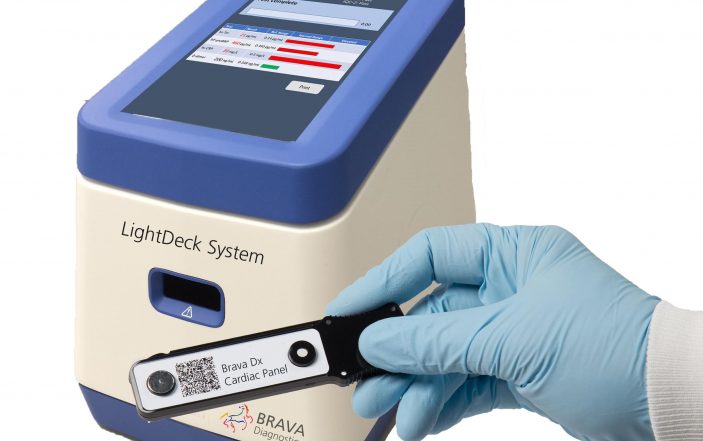Four new potentially game changing solutions to emergency room problems.
During ACEP19, four medical device innovations were featured at the InnovatED area of the Exhibit Hall. All four competed in a “shark tank” style pitch competition sponsored by AngelMD. Brava, a team focused on improved diagnostics of myocardial infarctions, won the competition. Other innovations included increased ECMO portability, ultrasound-based hemostasis for trauma patients and a microarchitecture matrix to speed wound healing.
Brava: Improved Diagnosis of Myocardial Infarction

When treating chest pain, how do we differentiate the 15% of patients with myocardial infarction from the other 85% who present with different causes of chest pain? Lab-based testing takes 60-to 90-minutes. Point-of-care troponin testing is more rapid, but also less sensitive and precise. To better meet the diagnostic needs of the ED, Brava is developing a high-sensitivity troponin test that can be completed in the ED, but also features both lab-quality performance and point-of-care speed. Their waveguide platform not only gives results in less than 15 minutes, but also satisfies both sensitivity and precision guidelines from the American College of Cardiology.
Carrie Mulherin, Brava’s co-founder, states that their “Brava High-Sensitivity Troponin Test will enable faster diagnosis of heart attack and enable more rapid rule-out and discharge of low-risk patients.” This could prevent unnecessary admissions, decrease ED crowding, and cut healthcare spending. While this would also improve patient satisfaction, it could increase the burden on nurses and ED techs. Brava is also developing point-of-care testing for both heart failure and sepsis. To learn more, go to Brava’s website or check out their demo video.
Elsuis: Portable and Compact ECMO

Elsius’s mission statement is to save more lives, shorten hospital stays and lower healthcare costs through their innovative Extra Corporeal Membrane Oxygenator (ECMO) device. ECMO is used to provide cardiopulmonary support for critical patients like those being treated for cardiac arrest, trauma, organ transplant, congenital disease and pneumonia from COVID-19.
“There are three issues with traditional ECMO: biocompatibility, transportation and versatility,” states Elsius CEO Allesandro Biglioli. “We’ve developed a biocompatible coating that reduces the inflammatory response and clotting. Our system is also compact, portable and can be transported by a single person.”
As opposed to traditional ECMO, which requires bulky equipment, multiple wires and access lines, the ELSIUS system integrates both the blood pump and the oxygenator into the same device, decreasing the need for tubing and a heat exchanger. Also, because their biocompatible coating decreases inflammatory reactions, there is a dramatically reduced need for heparin. Although their device improves on the current standard of care, one drawback is that it does not include a heat exchanger. However, Biglioli notes that it was intentionally excluded in order to reduce complexity and avoid exposure of blood to foreign surfaces. Learn more about ELSIUS via their website and this demo video.
Novuson: Stop the Bleed with Ultrasound

Novuson is using ultrasound, instead of electricity, for hemostasis. Due to safety concerns related to electrocution and fire, traditional electrocautery has limited ability to address heavy bleeding in trauma patients. However, ultrasound-based hemostasis is able to function in this environment, offering Emergency Physicians a new way to address active bleeding.
Novuson’s founder, Dr. Stuart Mitchell, notes that “while traditional electrosurgical devices cannot be used to control bleeding in trauma and emergency situations, Novuson’s Ultrastat technology will provide Emergency Physicians and Trauma Surgeons a technology that will shift the paradigm for bleeding-related case management.” He notes their device stops bleeding quickly, does not transmit electricity through patients, and does not burn or char tissue. To learn more, visit Novuson’s website and view their demo video.
Fesarius: Improved Wound Healing

Fesarius Therapeutics has developed a way to improve wound healing after skin and tissue loss from trauma, burns and infection. Currently, these wounds are often treated by harvesting and transplanting skin grafts from another site on the patient’s body. This process is not always feasible, often causes a second wound, and can prolong recovery time. Fesarius has solved this problem by creating DermiSphere, an innovative tissue scaffolding that uses microspheres embedded in a collagen hydrogel.
This novel approach relies on differential density interfaces which increases the rate of new cell formation and neovascularization, decreasing the time required for wound healing. Fesarius CEO Brett Spector states DermisSphere “will be a game-changing product for the treatment of acute full-thickness skin loss from burns and trauma.” To learn more, visit Fesarius Therapeutic’s website and check out their demo.



